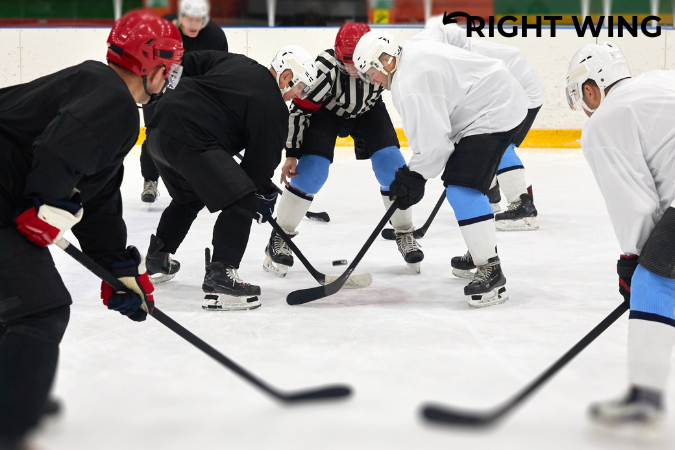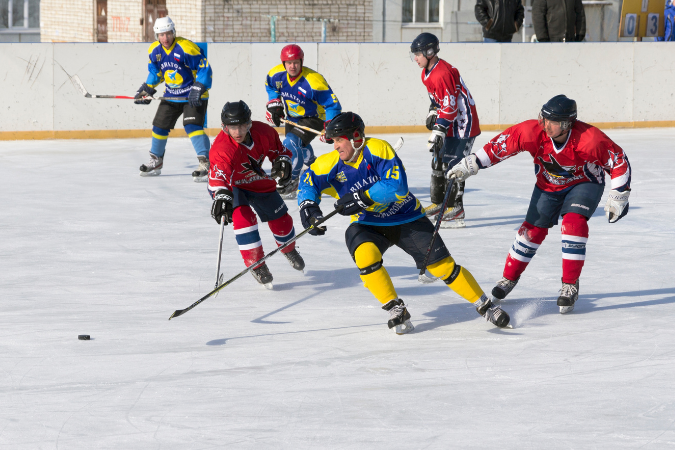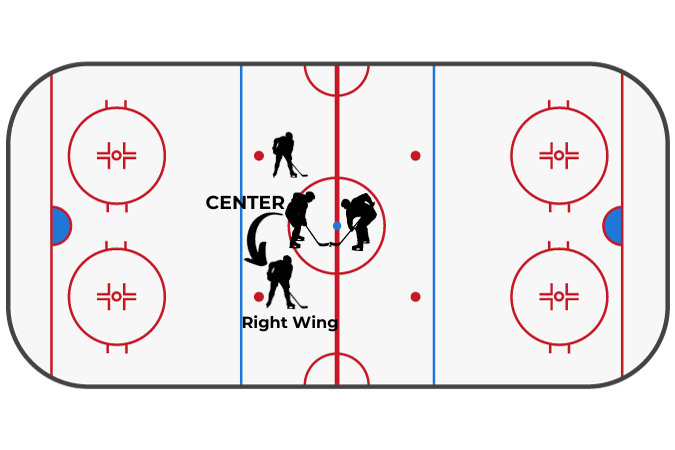How to Play Right Wing in Hockey
Wondering how to Play Right Wing in Hockey? Playing right wing in hockey requires a combination of offensive skills, defensive responsibility, physicality, and excellent game awareness. In this article, we will explore the fundamental duties of a right winger, including mastering offensive zone responsibilities, developing a defensive zone strategy, executing in the neutral zone, and understanding special teams contributions. We will also discuss key attributes of elite right wingers, the importance of continual learning and improvement, and how to harness the craft of a successful right winger.

Key Takeaways:
- Playing right wing in hockey requires a combination of offensive skills, defensive responsibility, physicality, and game awareness.
- The right winger must master offensive zone responsibilities, defensive zone strategy, executing in the neutral zone, and special teams contributions.
- Key attributes of elite right wingers include positioning, communication, physical play, and game awareness.
- Continual learning and improvement are crucial for becoming a successful right winger in hockey.
- By following proper techniques and continuously honing your skills, you can excel in the right wing position and make a significant impact on the ice.
The Fundamental Duties of a Right Winger in Hockey

The fundamental duties of a right winger in hockey encompass various aspects of the game. As a right winger, mastering offensive zone responsibilities is crucial for contributing to the team’s success. In the offensive zone, a right winger must:
Mastering Offensive Zone Responsibilities
- Create scoring opportunities by driving to the net and finding open spaces
- Support teammates by providing passing options and maintaining good positioning
- Make quick and accurate passes to set up scoring chances
- Be in position to shoot on goal and capitalize on scoring opportunities
Developing a solid defensive zone strategy is equally important for a right winger. In the defensive zone, a right winger must:
Developing a Defensive Zone Strategy
- Backcheck diligently to disrupt the opponent’s offensive play
- Support defensemen by providing an outlet option and covering opponents in the defensive zone
- Prevent the opposition from generating scoring chances by blocking shots and disrupting passes
Executing in the neutral zone is another key aspect of a right winger’s responsibilities. In the neutral zone, a right winger must demonstrate:
Executing in the Neutral Zone
- Awareness of the game situation and the ability to make smart decisions with the puck
- Effective communication with linemates and defensemen to maintain puck possession
- Transition from defense to offense and vice versa by carrying the puck or making a clean pass
To be a complete player, a right winger needs to understand the importance of special teams contributions. These contributions include:
Understanding Special Teams Contributions

- Playing a valuable role on the power play by setting up scoring plays and creating havoc in front of the net
- Contributing to the penalty kill by pressuring the opposition and disrupting passing lanes
- Being disciplined and responsible to avoid unnecessary penalties that could cost the team
By mastering offensive zone responsibilities, developing a defensive zone strategy, executing in the neutral zone, and understanding special teams contributions, a right winger can make a significant impact on the team’s performance.
How to Play Right Wing in Hockey
Playing right wing in hockey requires a combination of skills and knowledge. To become a successful right winger in hockey, it is essential to master various aspects of the game. This section will delve deeper into the specifics of playing right wing, covering key areas such as positioning, offensive duties, defensive responsibilities, communication, physical play, and game awareness.
Positioning

Proper positioning is crucial for a right winger. It involves finding the right spots on the ice to support your teammates offensively and defensively. In the offensive zone, positioning yourself in scoring areas and anticipating plays can lead to more scoring opportunities. In the defensive zone, ensuring you are in the right position to backcheck and support your defensemen can help prevent the opposition from generating scoring chances.
Offensive Duties
As a right winger, you have important offensive responsibilities. These include creating scoring opportunities by driving to the net, finding open spaces, and being ready to shoot. It is also crucial to support your teammates and make quick, accurate passes to maintain puck possession. By understanding offensive strategies and using your skills effectively, you can contribute to your team’s success.
Defensive Responsibilities

While the right winger is primarily an offensive player, defensive responsibilities should not be overlooked. Backchecking diligently, covering the opposition’s defenseman, and preventing scoring chances are critical aspects of a right winger’s role. By being aware of your defensive responsibilities and communicating with your teammates, you can be a reliable presence in the defensive zone.
Communication
Effective communication is vital in hockey, and as a right winger, you need to communicate with your linemates, defensemen, and goaltender. By providing clear and concise instructions, signaling for passes, and calling out plays, you can enhance team chemistry and coordination on the ice.
Physicality is an important aspect of hockey, and as a right winger, you need to be physically engaged in the game. Winning battles along the boards, using your body to shield the puck, and delivering clean body checks can create space for yourself and your teammates. Developing your strength, balance, and agility will make you more effective in physical play situations.
Game Awareness
To excel as a right winger, you must have a high level of game awareness. This includes being aware of the position of your teammates and opponents, anticipating plays, and making quick decisions with the puck. By continuously honing your game awareness through practice and game experience, you can make better choices and contribute more effectively to your team’s success.
By following these steps and continuously working on your skills, you can become a successful right winger in hockey. Remember, playing right wing requires a combination of offensive and defensive abilities, as well as excellent positioning, communication, physical play, and game awareness. With dedication and hard work, you can thrive in this important role on the ice.
Conclusion
Playing right wing in hockey is both rewarding and challenging. As a right winger, I understand the importance of harnessing the craft of this position and embodying the key attributes of elite right wingers. By doing so, you can elevate your game and make a significant impact on the ice.
To become a successful right wing player in hockey, continual learning and improvement should be a priority. No matter your skill level, there is always room to grow and enhance your abilities. Stay dedicated to refining your skills, studying the game, and seeking opportunities to learn from experienced players and coaches.
Key attributes of elite right wingers include speed, agility, strong puck-handling skills, and the ability to make quick decisions under pressure. Additionally, effective communication with your teammates and a strong work ethic are essential to excel in this position.
Remember, the journey of playing right wing in hockey is a process. Embrace the challenges, stay committed to your development, and strive to be the best version of yourself on and off the ice. When you combine talent with a strong work ethic and a passion for the game, you can achieve great things as a right winger.
FAQ
What are the fundamental duties of a right winger in hockey?
The fundamental duties of a right winger in hockey include mastering offensive zone responsibilities, developing a defensive zone strategy, executing in the neutral zone, and understanding special teams contributions.
What are offensive zone responsibilities for a right winger?
Offensive zone responsibilities for a right winger include creating scoring opportunities, supporting teammates, making quick passes, and being in position to shoot on goal.
What is a defensive zone strategy for a right winger?
A defensive zone strategy for a right winger involves backchecking diligently, supporting defensemen, and preventing the opposition from generating scoring chances.
What is the role of a right winger in the neutral zone?
The role of a right winger in the neutral zone requires awareness, effective communication, and the ability to make smart decisions with the puck.
How can right wingers contribute to special teams play?
Right wingers can contribute to special teams play by playing a valuable role on the power play and penalty kill.
How can I become a successful right winger in hockey?
To become a successful right winger in hockey, it is important to focus on positioning, offensive duties, defensive responsibilities, communication, physical play, and game awareness. Continuous practice and improvement are also key factors.
What are some key attributes of elite right wingers?
Some key attributes of elite right wingers include strong skating abilities, excellent shooting skills, hockey IQ, playmaking ability, and the ability to excel in both offensive and defensive situations.
Why is continual learning and improvement important for right wingers?
Continual learning and improvement are important for right wingers because the game of hockey is constantly evolving, and to stay at the top of their game, players must adapt to new strategies, techniques, and tactics.
Source Links
- https://howtohockey.com/the-role-of-a-winger-in-hockey/
- https://www.hockeymonkey.com/learn/hockey-left-right-wing
- https://www.freshgear.com/hockey-faqs/how-to-play-right-wing-in-hockey/




